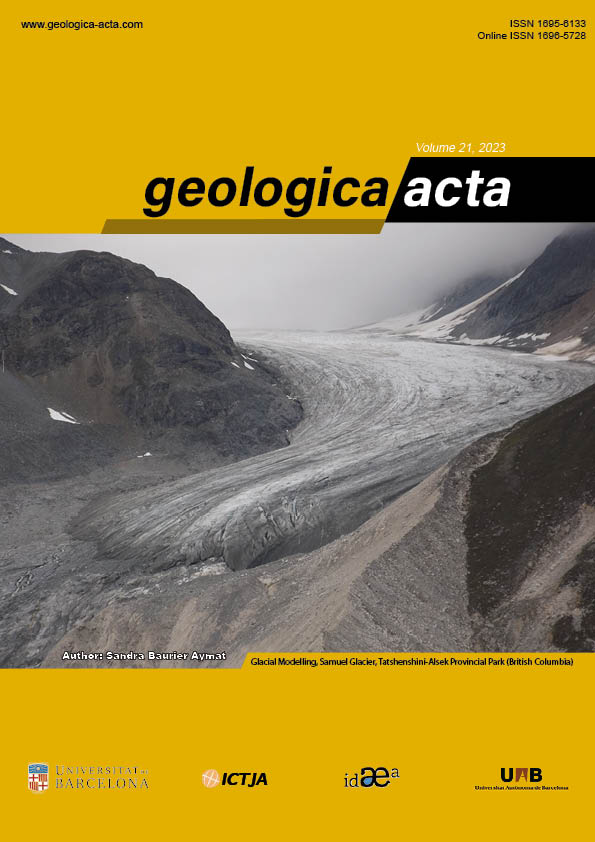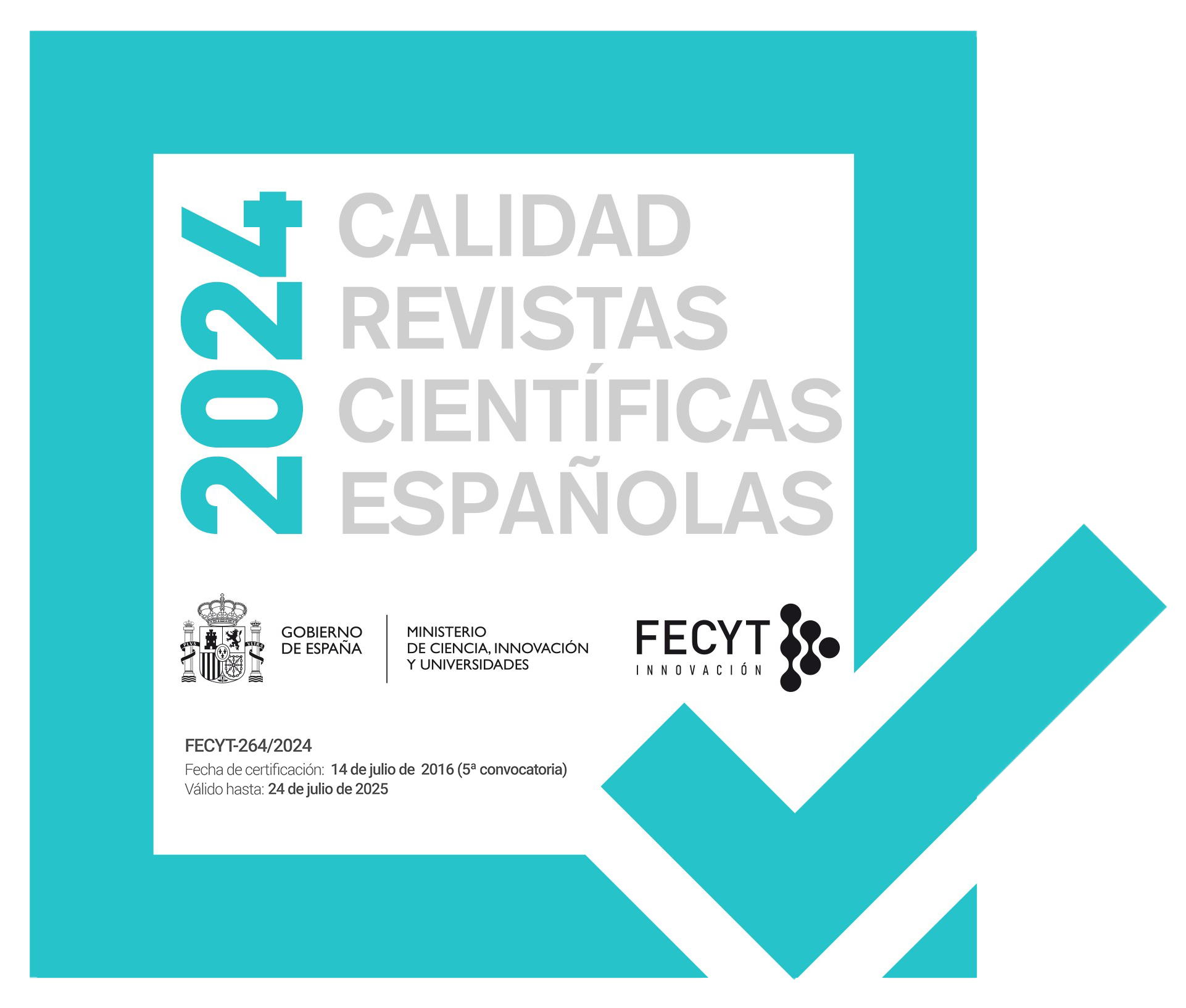Understanding the spatio-temporal evolution of fractures in pillow basalt
DOI:
https://doi.org/10.1344/GeologicaActa2023.21.8Keywords:
Pillow basalt, Thermal stress, Fractures, Computational simulation, Dharwar cratonAbstract
We investigated the origin and spatio-temporal evolution of cooling fractures in pillow basalt which undergo thermal contraction after their eruption in an aqueous environment. Through a computer-based simulation using Fourier transformation, the thermo elastic stress displacement profiles within individual pillow units are determined. The scaled model (pillow diameter - 1 meter) generated radial, linear fractures perpendicular to pillow margin and irregular discrete flaws in the pillow interior like the ones observed in natural examples. Radial linear fractures of 3–5 centimetre in length have been measured in pillows of average one-metre diameter from the Maradihalli region, in the Chitradurga Schist Belt, India. An estimated time of 94–118 minutes was required to get radial fractures of similar length in the simulation. Our model efficiently replicated the generation and distribution of thermal fractures and allowed an estimation of cooling time for the peripheral glassy zone but has limitations in deciphering the formation of fracture networks in progressively crystalline inner zone of pillows.
References
Thomas, W.A., 2005. Tectonic inheritance at a continental margin. GSA Today, 16(2), 4–11.
Vogt, T., 1938. The stratigraphy and tectonics of the Old Red formations of Spitsbergen. Abstracts of the Proceedings of the Geological Society London, 1343, 88.
Wiest, J.D., Wrona, T., Bauck, M.S., Fossen, H., Gawthorpe, R.L., Osmundsen, P.T., Faleide, J.I., 2020. From Caledonian Collapse to North Sea Rift: The History of a Metamorphic Core Complex. Tectonics, 39, e2020TC006178. DOI: doi.org/10.1029/2020TC006178
Witt-Nilsson, P., Gee, D.G., Hellman, F.J., 1998. Tectonostratigraphy of the Caledonian Atomfjella Antiform of northern Ny Friesland, Svalbard. Norsk Geologisk Tidsskrift, 78, 67–80.
Ziemniak, G., Majka, J., Manecki, M., Walczak, K., Jeanneret, P., Mazur, S., Kosminska, K., 2020. Early Devonian sinistral strike-slip in the Caledonian basement of Oscar II Land advocates for escape tectonics as a major mechanism for Svalbard terranes assembly. Vienna (Austria), May 3rd–8th 2020, European Geoscience Union (EGU) General Assembly, Geophysical Research Abstracts, EGU General Assembly 2020. DOI: doi.org/10.5194/egusphere-egu2020-1044.
Ziemniak, G., Majka, J., Manecki, M., Walczak, K., Jeanneret, P., Mazur, S., Kosminska, K., 2022. Early Devonian sinistral shearing recorded by retrograde monazite(-Ce) in Oscar II Land, Svalbard. Mineralogia, 53, 82–108. DOI: doi.org/10.2478/mipo-2022-0007.
Fox, R.W., McDonald, A.T., Mitchell, J.W., 2020. Fox and McDonald’s introduction to fluid mechanics. John Wiley & Sons, 421-438.
Incropera, F.P., DeWitt, D.P., 2002. Introduction to heat transfer. John Wiley & Sons, 561-681.
Jayananda, M., Chardon, D., Peucat, J.J., Capdevila, R., 2006. 2.61 Ga potassic granites and crustal reworking in the western Dharwar craton, southern India: tectonic, geochronologic and geochemical constraints. Precambrian Research, 150(1-2), 1-26. DOI: http://dx.doi.org/10.1016/j.precamres.2006.05.004
Johnston, W.G.Q., 1969. Pillow lava and pahoehoe: a discussion. The Journal of Geology, 77(6), 730-732.
Lienhard, J.H., 2005. A heat transfer textbook. Phlogistron Press, 467-517.
Liu, L., Lowell, R.P., 2011. Modeling heat transfer from a convecting, crystallizing, replenished silicic magma chamber at an oceanic spreading center. Geochemistry, Geophysics, Geosystems, 12(9), 1-17. DOI: 10.1029/2011GC003612
Macdonald, G.A., 1972. Volcanoes. Prentice Hall Inc. New Jersey, Englewood Cliffs, 1-501.
Manikyamba, C., Ganguly, S., Pahari, A., 2021. Geochemical Features of Bellara Trap Volcanic Rocks of Chitradurga Greenstone Belt, Western Dharwar Craton, India: Insights into MORB-BABB Association from a Neoarchean BackArc Basin. Journal of Earth Science, 32(6), 1528-1544. DOI: https://doi.org/10.1007/s12583-021-1472-5
Moore, J.G., 1975. Mechanism of formation of pillow lava: pillow lava, produced as fluid lava cools underwater, is the most abundant volcanic rock on earth, but only recently have divers observed it forming. American Scientist, 63(3), 269-277.
Moore, J.G., Lockwood, J.P., 1978. Spreading cracks on pillow lava. The Journal of Geology, 86(6), 661-671.
Mondal, T.K., 2018. Evolution of fabric in Chitradurga granite (south India)-A study based on microstructure, anisotropy of magnetic susceptibility (AMS) and vorticity analysis. Tectonophysics, 723, 149-161. DOI: https://doi.org/10.1016/j.tecto.2017.12.013
Mondal, T.K., Mamtani, M.A., 2014. Fabric analysis in rocks of the Gadag region (southern India)—implications for time relationship between regional deformation and gold mineralization. Tectonophysics, 629, 238-249. DOI: http://dx.doi.org/10.1016/j.tecto.2013.09.021
Naqvi, S.M., Rogers, J.J.W., 1987. Precambrian geology of India. USA, Oxford University Press, 1-223. DOI: https://doi.org/10.1017/S0016756800013492
Nayfeh, A.H., 2008. Perturbation methods. John Wiley & Sons, 23-55.
Nichols, A.R., Potužák, M., Dingwell, D.B., 2009. Cooling rates of basaltic hyaloclastites and pillow lava glasses from the HSDP2 drill core. Geochimica et Cosmochimica Acta, 73, 1052-1066.
Perry, J.H., 1950. Chemical engineers’ handbook, 2-1:362. McGraw Hill Education.
Philpotts, A.R., Lewis, C.L., 1987. Pipe vesicles—an alternate model for their origin. Geology, 15(10), 971-974.
Pletcher, R.H., Tannehill, J.C., Anderson, D., 2012. Computational fluid mechanics and heat transfer. CRC press, 621-675.
Ramsay, W.R.H., Moore, P.R., 1985. Mineralogy and chemistry of a pillow lava, Northland, New Zealand, and its tectonic significance. New Zealand Journal of Geology and Geophysics, 28(3), 471-485.
Roy, A., Ramachandra, H.M., Sengupta, S., 2020. Interpretation of stratigraphy and structure of the Neoarchaean Dharwar Supergroup of rocks in Chitradurga area, Dharwar Craton. Journal of Earth System Science, 129(1), 1-21. DOI: http://dx.doi.org/10.1007/s12040-020-1350-z
Snyder, G.L., Fraser, G.D., 1963. Pillowed lavas: Intrusive layered lava pods and pillowed lavas, Unalaska Island, Alaska, and a review of selected recent literature. Professional Paper, (454-BC). DOI: https://doi.org/10.3133/pp454BC
Som, S.K., 2008. Introduction to heat transfer. PHI Learning Pvt. Ltd, 390-413.
Timoshenko, S., Goodier, J.N., 1951. Theory of Elasticity. New York, McGraw-Hill Book Company Inc, 398-433.
Vuagnat, M., Pustaszeri, L., 1965. Reflexions sur la structure et le mode de formation des couldes en coussins du Montgenevre(Hautes Alpes). Geneva, Archives Sci., 18(3), 686-689.
Wells, G.N., Bryan, W.B., Pearce, T.H., 1979. Comparative Morphology of Ancient and Modern Pillow Lavas. The Journal of Geology, 87, 427-440.
Yazar, E.A., 2018. Alteration mineralogy, mineral chemistry and stable isotope geochemistry of the Eocene pillow lavas from the Trabzon area, NE Turkey. Journal of African Earth Sciences, 138, 149-166. DOI: https://doi.org/10.1016/j.jafrearsci.2017.11.014
Zhang, H., Zhu, Y., 2018. Geology and geochemistry of pillow basalt in the Huilvshan region (west Junggar, China): implications for magma source and tectonic setting. Canadian Journal of Earth Sciences, 55(12), 1339-1353. DOI: https://doi.org/10.1139/cjes-2018-0090
Downloads
Published
Issue
Section
License
Copyright (c) 2023 Geologica Acta

This work is licensed under a Creative Commons Attribution-ShareAlike 4.0 International License.
Copyright
Geologica Acta is the property of the UB, GEO3BCN, IDAEA and UAB. Geologica Acta must be cited for any partial or full reproduction. Papers are distributed under the Attribution-Share Alike Creative Commons License. This license allows anyone to reproduce and disseminate the content of the journal and even make derivative works crediting authorship and provenance and distributing possible derivative works under the same or an equivalent license.
Author Rights
Authors retain the copyright on their papers and are authorized to post them on their own web pages or institutional repositories. The copyright was retained by the journal from the year 2003 until 2009. In all cases, the complete citation and a link to the Digital Object Identifier (DOI) of the article must be included.
The authors can use excerpts or reproduce illustrations of their papers in other works without prior permission from Geologica Acta provided the source of the paper including the complete citation is fully acknowledged.




